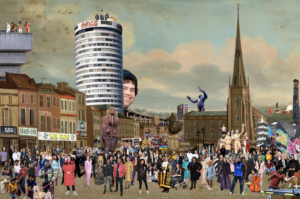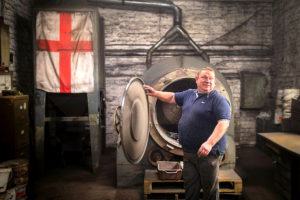I have a sneaking admiration for Heather Wheeler — the Conservative MP who, with wonderful tactlessness, recalled a meeting in “Birmingham or some other Godawful place”. She only said out loud what most of her colleagues must think as they endure meetings in the bland anomie of the International Convention Centre — a building, incidentally, that the Thatcher government objected to because it broke the rules on local government spending. Even those of us who come from Birmingham and love the place would have to admit that the city’s charms are not always obvious to the naked eye.
And yet it is in Birmingham that the two contenders for the Conservative leadership will face each other tomorrow, and it is there again that the winner will address the party at its annual conference in October. So, what makes the current Conservative Party so keen to court the city?
Part of the answer to this question lies in the very incongruity of the association between Birmingham and the party. At a time when the competition for Tory leadership pits a woman who began her career at Shell against a man who began his at Goldman Sachs, Conservative spin doctors want to create some distance from the global capitalist elite. Birmingham is a good place to start. Shell had a small back-office there once but most of its back-office work is now done out of Chennai or Manila. As for Goldman Sachs, I suspect that most of its employees have never set foot in Birmingham — though some of the more erudite ones may recall that there was once a Birmingham stock exchange, which closed in 1986, just as the London exchange took off.
More generally, in the aftermath of Brexit, Conservatives like to see themselves as representatives of “deep England”. Birmingham, an unglamorous city in the centre of the nation, looks like the capital of this fantasyland from the Home Counties. When people, Tories especially, imagine the “real England”, it is almost invariably rural and, to a surprising extent, rural imagery often comes from Birmingham. Think of Tolkien’s “Middle Earth”, a place that seems to derive from the — then semi-rural — suburb of Birmingham in which the author grew up. Radio 4, keen to demonstrate its non-metropolitan credentials, sometimes ships its presenters to Birmingham for a few hours of Today or Start the Week, but practically the only BBC programme that is still produced in the city is The Archers. It was in here that Theresa May delivered her speech of 2016 in which she remarked that “citizens of the world” were “citizens of nowhere”.
Birmingham is also a perfect case study for the current Conservative fascination with “levelling up” the provinces. Joseph Chamberlain, much admired by May’s advisor Nick Timothy, is often presented as having been the incarnation of municipal activism when he was mayor of Birmingham in the 1870s. Later, after he moved to national politics and left the Gladstonian Liberals to join forces with the Tories, he became the incarnation of Right-wing populism.
There are, however, some odd things about Birmingham’s current place in the Tory imagination. The notion that its population is deeply rooted would not survive the briefest glance at the census. If anything characterises the city, it is migration. Work has always drawn people there — from surrounding counties in the 19th century, from Wales in the Thirties (3% of the entire employed population of the principality moved to the Midlands) and from overseas in the period since 1945. Go back a generation or two and the “somewhere” from which Birmingham people come is likely to be Galway, St Kitts or the Punjab. Birmingham Conservatives, by the way, did not always have easy relations with the city’s immigrant population — though were more discreet in the expression of their opinions than their counterparts in neighbouring Smethwick, who became notorious for using a racist slogan in the 1964 general election.
As for “levelling up”, the city’s history shows how vacuous the concept is. Joseph Chamberlain was a powerful local figure who had great resources at his disposal. Birmingham’s rise was engineered by its own local elites, particularly the network of intermarried Unitarian families who gathered around Chamberlain. He did not depend on favours from national government. The current Conservative mayor of the West Midlands — Andy Street — is an amiable and well-meaning man but hardly in the Chamberlain mould. He won his position by a narrow majority: the proportion who voted against having a regional mayor at all, in a 2012 referendum, was larger than the proportion who voted in favour of having a Tory one in the 2017 election. He also has little money to spend: Conservatives in the Eighties stripped local government of much of its financial power. And while Chamberlain ran a small empire of municipal enterprises, the initiatives that come from Andy Street are less tangible — I suspect that most people living in the band that extends from the university to the site of the old Longbridge factory (my mother among them) would be surprised to hear that they inhabit the “Central Technology Corridor”.
In any case, Birmingham people with long memories may suspect that central government attempts to level up are more likely to be a source of problems than a solution. Many of the city’s economic problems in the Eighties sprang from the fact that the Board of Trade, keen to move industry to the “Development Areas” of the North, refused to grant permission for the establishment of new factories in Birmingham. As a result, the city was frozen into an economy that revolved around motor manufacture.
The relations between Conservatism and Birmingham are, in fact, so odd that it is worth dwelling on their history — a history that might raise awkward questions. In political terms, Birmingham was born in opposition to Toryism. It first attained parliamentary representation as a result of the 1832 Reform Bill, but not as a passive beneficiary of largesse from London. The Birmingham Political Union had been one of the most important instruments in bringing the Reform Bill about, and it had done so in opposition to the most famous Tory of the early 19th century: the Duke of Wellington. For slightly more than the first half-century of its parliamentary representation, Birmingham only once, and briefly, returned a Tory MP.
In some ways, the city was an anti-Conservative place even before there was much in the way of formal political activity there. The ancien régime institutions that Toryism existed to defend were all weak in Birmingham. There was no real aristocracy in the town. It is true that the aristocratic Calthorpes owned the Edgbaston estate — which became the suburb in which much of the local bourgeoisie lived. But the Calthorpes were not really great figures in the city, and a member of the family was trounced when he was foolish enough to stand as a Conservative in opposition to the Chamberlainite Liberal machine.
Meanwhile, in statistical terms, Birmingham was an Anglican town (unlike the industrial towns of the North). Still, it had no Cathedral until the 20th century. The only real centre of Anglican and Tory power, until the City council managed to bring it to heel, was King Edward’s grammar school, which had been run since the 16th century by a self-selecting oligarchy of governors. King Edward’s has indeed produced some significant Tories but the intellectual self-confidence that the school imparts does not always fit easily with the party. One sees this in David Willetts, so intelligent that he sometimes doubts that he is really a Tory, and Enoch Powell, so intelligent that he made the rest of his party doubt that they were really Tories.
No one incarnated Birmingham’s natural anti-Tory bent better than Joseph Chamberlain. At a time when the Conservatives stood for Church and crown, he began his career as a republican and ended it as an atheist. He regarded the aristocracy with open contempt. However, he broke with Gladstone over Home Rule in 1886 and, thereafter, worked in alliance with the Conservatives. Birmingham became a Conservative, or, strictly speaking, a Unionist city, and this was seen most strikingly after Joseph’s death. Between the wars, there were times when Conservative cabinets contained three Birmingham MPs, including Joseph’s sons, Austen and Neville.
Neville, though, was both the epitome of Conservative success in Birmingham and the instrument of its downfall. When he became prime minister in 1937, every single Birmingham MP was a Conservative. In 1945, five years after his death, the Labour Party won ten out of the 13 Birmingham seats. This was partly because appeasement so discredited the Chamberlain tradition (though several Birmingham Conservative MPs had, in fact, opposed it) and partly because the war economy had created a more self-conscious and unionised working class. Factories associated with the motor industry had been centres of Tory power between the wars. Herbert Austin, owner of the Longbridge car factory, was a Conservative MP who often sacked trade unionists and kept his men working late to stop them voting in municipal elections. Austin, like Chamberlain, died early in the war; by its end, Longbridge was heavily unionised.
Birmingham was a boom town after 1945. School leavers could find jobs in days. Conservatives were not always comfortable with full employment. Walter Higgs, a motor manufacturer who had been Conservative MP for West Birmingham, remarked, just after the 1945 election, that “the only way to get Birmingham people to work is have ten men after every nine jobs and empty bellies”. Another notable wrote in a private report that Conservatism in Birmingham was suffering from “over full employment”. But, though prosperity broke the Conservative monopoly of the Thirties, it did not create a new monopoly for Labour. Birmingham voters were what sociologists labelled “affluent workers”. Their support for Labour was an instrumental one based on what they took to be their interests rather than a product of ancestral loyalties. It may be because loyalty to Labour was never particularly deep that the city never turned against the party with the bitterness seen in some Northern constituencies in recent years.
In retrospect, it is obvious that the turning point for Birmingham came in 1979. “Thatcherism” was made in Birmingham — in the sense that Stuart Hall’s article on “The Great Moving Right Show” (published in Marxism Today in January 1979), which first used the term “Thatcherism” in a systematic way, was written while he was at the Birmingham Centre for Contemporary Cultural Studies. It was made in Birmingham too in that Thatcher’s Conservative Party came to define itself against two displays of working-class power — that seen in 1972 when striking miners and their allies from Birmingham blockaded the Saltley coke depot and that seen in strikes at the Longridge car factory, which was, by now, part-nationalised.
There was, though, something strange in all this. Significant numbers of Birmingham people voted Conservative in 1979. It was no surprise that Sutton Coldfield (a leafy suburb that had only been annexed to the city in 1974) should have the largest Conservative majority in the country. It was odder that Northfield and Selly Oak — the two constituencies closest to the Longbridge car plant — both went Tory in 1979. Partly, this was the last hurrah of the post-war “affluent worker” — a vote against the pay restraint of the Callaghan government. Sections of the white working class perhaps expected the Thatcher government to be more radical on social and cultural issues (particularly immigration) than it turned out to be. Birmingham people certainly did not expect the Tories to be so radical on economic issues and the city’s economy dived in the early Eighties — this was the era when UB40 were in the charts and when the Kenrick and Jefferson stationery company were said to be almost the only thriving local business because they had the contract to print UB40 forms.
Birmingham has regained much of its prosperity in recent years but the vestiges of the Thatcher years are still visible. The city includes areas with some of the highest unemployment rates in the country. The Longbridge factory finally closed in the early part of this century and the area around it is the one area that resembles the “Red Wall” Tory seats of the North — it voted for Brexit and voted Conservative in 2019. However, the prosperous commuters of Sutton Coldfield and the white ex-car workers (or their widows) of Northfield are now the only people in Birmingham to vote Conservative. All the other eight Birmingham constituencies returned Labour MPs at the last election.
The oddest thing about Tory evocations of Birmingham is the very idea that the city ought to stand for something. It is a big, heterogeneous place and, partly because of its catastrophic development around busy roads in the Sixties and Seventies, different parts of the city can feel utterly separate from each other. The notion that this is “deep England” is a myth — but then, so is the notion that there is a “deep England”. The Tory fantasy implies something permanent and natural — rural, even (one thinks of Churchill addressing the population “in your cottages”). Yet Birmingham is above all a man-made place. It manufactured an image of rural England as much as it once manufactured the Spitfire. Any local asked to identify a landmark would talk about Spaghetti Junction or the Sentinel towers, rather than a hill or river. Joseph Chamberlain, meanwhile, would have despised all the talk of “heritage”, “ancestry” and “roots” that goes with deep England; he knew that the Tory party he helped create was no more “natural” than the orchids he grew in his hothouse. For him and his associates, Birmingham went, above all, with the phrase “self-made”.
Disclaimer
Some of the posts we share are controversial and we do not necessarily agree with them in the whole extend. Sometimes we agree with the content or part of it but we do not agree with the narration or language. Nevertheless we find them somehow interesting, valuable and/or informative or we share them, because we strongly believe in freedom of speech, free press and journalism. We strongly encourage you to have a critical approach to all the content, do your own research and analysis to build your own opinion.
We would be glad to have your feedback.
Source: UnHerd Read the original article here: https://unherd.com/





